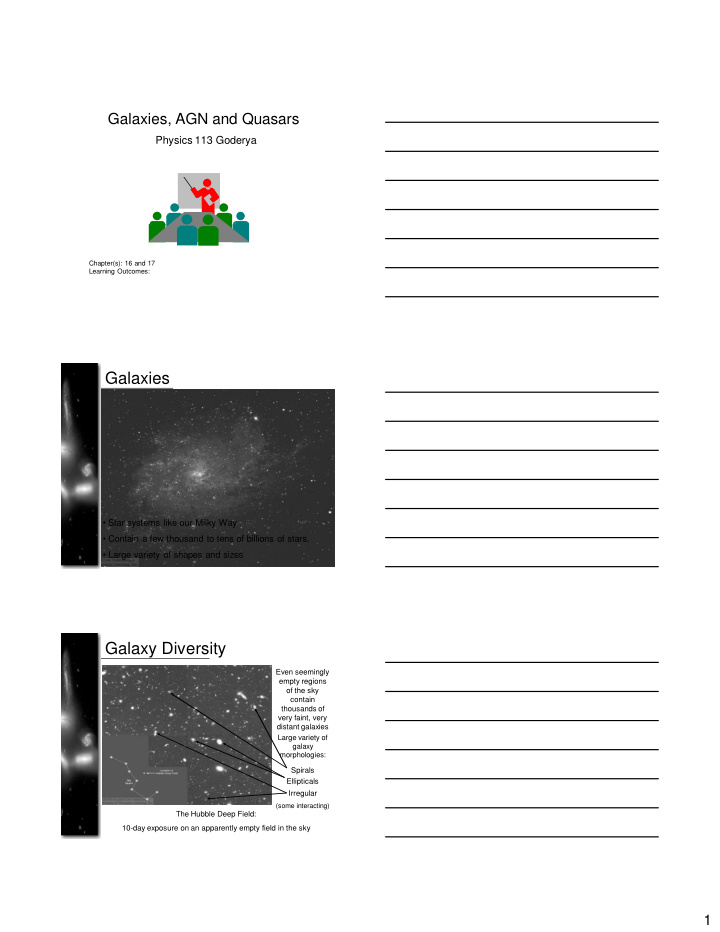



Galaxies, AGN and Quasars Physics 113 Goderya Chapter(s): 16 and 17 Learning Outcomes: Galaxies • Star systems like our Milky Way • Contain a few thousand to tens of billions of stars. • Large variety of shapes and sizes Galaxy Diversity Even seemingly empty regions of the sky contain thousands of very faint, very distant galaxies Large variety of galaxy morphologies: Spirals Ellipticals Irregular (some interacting) The Hubble Deep Field: 10-day exposure on an apparently empty field in the sky 1
Galaxy Classification E0, …, E7 Sa Large nucleus; E0 = tightly Spherical wound arms E1 Sb Sc Small nucleus; E7 = Highly loosely E6 elliptical wound arms Galaxy Types (SLIDESHOW MODE ONLY) Distance Measurements to Other Galaxies (1) a) Cepheid Method: Using Period – Luminosity relation for classical Cepheids: Measure Cepheid’s Period → Find its luminosity → Compare to apparent magnitude → Find its distance b) Type Ia Supernovae (collapse of an accreting white dwarf in a binary system): Type Ia Supernovae have well known standard luminosities → Compare to apparent magnitudes → Find its distances Both are “Standard-candle” methods: Know absolute magnitude (luminosity) → compare to apparent magnitude → find distance. 2
Cepheid Distance Measurement Repeated brightness measurements of a Cepheid allow the determination of the period and thus the absolute magnitude. → Distance The Most Distant Galaxies At very large distances, only the general characteristics of galaxies can be used to estimate their luminosities → distances. Cluster of galaxies at ~ 4 to 6 billion light years Distance Measurements to Other Galaxies (2): The Hubble Law E. Hubble (1913): Distant galaxies are moving away from our Milky Way, with a recession velocity, v r , proportional to their distance d : v r = H 0 *d H 0 � 70 km/s/Mpc is the Hubble constant • Measure v r through the Doppler effect → infer the distance 3
The Extragalactic Distance Scale • Many galaxies are typically millions or billions of parsecs from our galaxy. • Typical distance units: Mpc = Megaparsec = 1 million parsec Gpc = Gigaparsec = 1 billion parsec • Distances of Mpc or even Gpc � The light we see left the galaxy millions or billions of years ago!! • “Look-back times” of millions or billions of years Galaxy Sizes and Luminosities Vastly different sizes and luminosities: From small, low- luminosity irregular galaxies (much smaller and less luminous than the Milky Way) to giant ellipticals and large spirals, a few times the Milky Way’s size and luminosity Rotation Curves of Galaxies From blue / red shift of spectral lines across the galaxy → infer rotational velocity Plot of rotational velocity vs. distance from the center of Observe frequency of the galaxy: Rotation Curve spectral lines across a galaxy. 4
Determining the Masses of Galaxies Based on rotation curves, use Kepler’s 3 rd law to infer masses of galaxies Masses and Other Properties of Galaxies Active Galaxies Galaxies with extremely violent energy release in their nuclei (pl. of nucleus). → “Active Galactic Nuclei” (= AGN) Up to many thousand times more luminous than the entire Milky Way; energy released within a region approx. the size of our solar system! 5
The Spectra of Galaxies T aking a spectrum of the light from a normal galaxy: The light from the galaxy should be mostly star light, and should thus contain many absorption lines from the individual stellar spectra. Seyfert Galaxies Unusual spiral galaxies: • Very bright cores • Emission line spectra. • Variability: ~ 50 % in a few months NGC 1566 Most likely power source: Accretion onto a supermassive black hole (~10 7 – 10 8 M sun ) Circinus Galaxy Interacting Galaxies Seyfert galaxy NGC 4151 Seyfert galaxy NGC 7674 Active galaxies are often associated with interacting galaxies, possibly result of recent galaxy mergers. Often: gas outflowing at high velocities, in opposite directions 6
Cosmic Jets and Radio Lobes Many active galaxies show powerful radio jets Radio image Hot spots: Energy in of Cygnus A the jets is released in interaction with surrounding material Material in the jets moves with almost the speed of light (“Relativistic jets”). Quasars Active nuclei in elliptical galaxies with even more powerful central sources than Seyfert galaxies Also show strong variability over time scales of a few months. Also show very strong, broad emission lines in their spectra. The Spectra of Quasars Spectral lines show a large red shift of z = ∆λ / λ 0 = 0.158 The Quasar 3C 273 7
Quasar Red Shifts Quasars have been z = 0 detected at the highest red shifts, up to z = 0.178 z ~ 6 z = ∆λ / λ 0 z = 0.240 Our old formula z = 0.302 ∆λ / λ 0 = v r /c z = 0.389 is only valid in the limit of low speed, v r << c Quasar Red Shifts (2) The full, relativistic expression always gives speeds less than c, but extremely large distance: Several Gpc. Studying Quasars The study of high-redshift quasars allows astronomers to investigate questions of: 1) Large scale structure of the universe 2) Early history of the universe 3) Galaxy evolution 4) Dark matter Observing quasars at high redshifts: • distances of several Gpc • Look-back times of many billions of years • The universe was only a few billion years old! 8
Evidence for Quasars in Distant Galaxies Quasar 0351+026 at the same red shift as a galaxy → evidence for quasar activity due to galaxy interaction Galaxies Associated with Quasars Two images of the same quasar, 1059+730 New source probably a supernova in the host galaxy of the quasar Host Galaxies of Quasars Host galaxies of most quasars can not be seen directly because they are outshined by the bright emission from the AGN. Blocking out the light from the center of the quasar 3C 273, HST can detect the star light from its host galaxy. 9
Recommend
More recommend